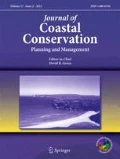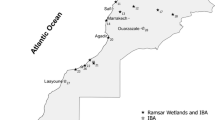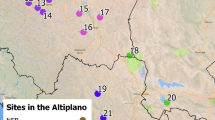Abstract
The aim of the paper is to examine the temporal and spatial changes observed over a 25-year period in the waterbird community nesting in the largest coastal lagoon around the Mediterranean; to examine driving factors for the observed changes; to address the most urgent conservation actions. Published sources and field surveys made between March and July were used to assess number of breeding pairs of the commonest waterbirds in 1990–1992, 2000–02 and 2012–14. The breeding waterbird community exhibited several changes in its structure, with an overall positive trend; the number of species increased from 14 to 25 and the mean yearly abundance increased from 6155 to 14,008 pairs. The diversity (H′) increased slightly, whereas similarity indices and nMDS ordination both highlighted clear differences between 1990 and 1992 and 2012–2014 communities. The increase in richness and abundance were mostly due to the immigration of birds from nearby wetlands, to the partial recovery of lagoon ecological conditions since the end of the 1980s and to the occurrence of suitable man-made habitats, such as fish farms, dredge islands and a constructed wetland. The fraction of the population nesting at artificial sites and fish farms increased from 50% in 1990–1992 till 80% in 2012–2014, highlighting the importance of artificial breeding sites in costal lagoons. At the opposite natural nesting habitats, such as saltmarshes and beaches are losing importance for breeding waterbirds, thus requiring urgent conservation measures.





Similar content being viewed by others
References
Almaraz P, Oro D (2011) Size-mediated non-trophic interactions and stochastic predation drive assembly and dynamics in a seabird community. Ecology 92:1948–1958
Amato S, Semenzato M, Borgoni N, Richard J, Tiloca G (1994) Status attuale delle popolazioni di Ardeidi nella Laguna di Venezia (Italia N-E). Riv ital Orn 63:200–204
Atkinson PW, Austin GE, Rehfisch MM, Baker H, Cranswick P, Kershaw M, Maclean IMD (2006) Identifying declines in waterbirds: the effects of missing data, population variability and count period on the interpretation of long-term survey data. Biol Conserv 130:549–559
Barausse A, Grechi L, Martinello N, Musner T, Smania D, Zangaglia A, Palmeri L (2015) An integrated approach to prevent the erosion of salt marshes in the lagoon of Venice. Environmental Quality 18:43–54
Basso M, Bon M (2015) Censimento degli uccelli acquatici svernanti in provincia di Venezia, Gennaio 2015. Provincia di Venezia. Servizio Caccia e Pesca. http://www.faunistiveneti.it/ svernanti_2015_ve.pdf. Accessed 22 February 2016
BirdLife International (2004) Birds in the European Union: a status assessment. BirdLife International, Wageningen, The Netherlands. Bird Life International
BirdLife International (2015) European red list of birds. Office for Official Publications of the European Communities, Luxembourg
Boldreghini P, Dall’Alpi A (2008) Measuring the abundance and diversity of a waterbird community: numbers or biomass? Revista Catalana d’Ornitologia 24:79–87
Borghesi F, Andreotti A, Baccetti N, Bianchi N, Birke M, Migani F, Dinelli E (2011) Flamingo feathers to monitor metal contamination of coastal wetlands: methods and initial results concerning the presence of mercury at six Mediterranean sites. Chem Ecol 27:137–151
Brichetti P, Foschi UF (2006) Evoluzione delle popolazioni di Laridae e Sternidae nidificanti nelle Valli di Comacchio nel periodo 1977-2001. Avocetta 30:41–50
Brigolin G, Facca D, Franco A, Franzoi P, Pastres R, Sfriso A, Sigovini M, Soldatini C, Tagliapietra D, Torricelli P, Zucchetta M, Pranovi F (2014) Linking food web functioning and habitat diversity for an ecosystem based management: a Mediterranean lagoon case-study. Mar Environ Res 97:58–66
Burton NH, Evans PR, Robinson MA (1996) Effects on shorebird numbers of disturbance, the loss of a roost site and its replacement by an artificial island at Hartlepool, Cleveland. Biol Conserv 77:193–201
Clutton-Brock T, Sheldon B (2010) Individuals and populations: the role of long-term, individual-based studies of animals in ecology and evolutionary biology. Trends in Ecology and Evolution 25:562–573
Colwell RK (2013) EstimateS. Statistical estimation of species richness and shared species from samples. Version 9. URL: purl.oclc.org/estimates
Deceuninck B (2001) Breeding waders in France: populations, trends and distributions: 1984-1996. Wader Study Group Bulletin 95:45–50
Farinos P, Robledano F (2010) Structure and distribution of the waterbird community in the mar Menor coastal lagoon (SE Spain) and relationships with environmental gradients. Waterbirds 33:479–493
Farinos P, Robledano F, Perona C, Soto AJ (2013) Lagoons as a waterbird habitat: response of communities to human impact and management across space and time scale. In: Mwinyihija M (ed) Lagoons: habitat & species, human impacts & ecological effects. Nova Science Publishers, pp. 2–51
Fox AD, Madsen J (1997) Behavioural and distributional effects of hunting disturbance on waterbirds in Europe: implications for refuge design. J Appl Ecol 5:1–13
Galewski T, Collen B, McRae L, Loh J, Grillas P, Gauthier-Clerc M, Devictor V (2011) Long-term trends in the abundance of Mediterranean wetland vertebrates: from global recovery to localized declines. Biol Conserv 144:1392–1399
Garaita R, Arizaga J (2015) The benefits of a constructed lagoon for the conservation of Eurasian spoonbills (Platalea leucorodia) in a tidal marsh. J Nat Conserv 25:35–41
Gayet G, Guillemain M, Mesléard F, Fritz H, Vaux V, Broyer J (2011) Are mute swans (Cygnus olor) really limiting fishpond use by waterbirds in the Dombes, eastern France ? J Ornithol 152:45–53
Gayet G, Croce N, Grillas P, Nourry C, Deschamps C, Rau PD (2012) Expected and unexpected effects of waterbirds on Mediterranean aquatic plants. Aquat Bot 103:98–105
Hale WG, Scarton F, Valle R (2005) The taxonomic status of the redshank Tringa totanus in Italy. Bulletin of the British Ornithological Club 125:261–275
Hammer Ø, Harper DAT, Ryan PD (2001) PAST: Paleontological Statistics Software Package for Education and Data Analysis. Palaeontologia Electronica 4: 9. Web: http://folk.uio.no/ohammer/past
Heath MF, Evans MI, Hoccom DG, Payne AJ, Peet NB (eds) (2000) Important bird areas in Europe: priority sites for conservation, volume 1 northern Europe, volume 2 southern Europe. UK. BirdLife International, Cambridge
Humphries CJ, Williams POH, Vane-Wright RI (1995) Measuring biodiversity value for conservation. Annu Rev Ecol Syst:93–111
Kingsford RT, Thomas RF (2004) Destruction of wetlands and waterbird populations by dams and irrigation on the Murrumbidgee River in arid Australia. Environ Manag 34:383–396
Liordos V (2010) Foraging guilds of waterbirds wintering in a Mediterranean coastal wetland. Zool Stud 49:311–323
Ma Z, Wang Y, Gan X, Li B, Cai Y, Chen J (2009) Waterbird population changes in the wetlands at Chongming Dongtan in the Yangtze river estuary. China Env Mgmt 43:1187–1200
Magurran A (2004) Measuring biological diversity. Blackwell Publishing, Malden
Melvin SL, Webb JW (1998) Differences in the avian communities of natural and created Spartina alterniflora salt marshes. Wetlands 18:59–69
Mezzavilla F, Scarton F (eds.) (2002) Le garzaie in Veneto. Quaderni Faunistici n.1. Associazione Faunisti Veneti, 95 pp
Nardelli R, Andreotti A, Bianchi E, Brambilla M, Brecciaroli B, Celada C, Dupré E, Gustin M, Longoni V, Pirrello S, Spina F, Volponi S, Serra L (2015) Rapporto sull’applicazione della Direttiva 147/2009/CE in Italia: dimensione, distribuzione e trend delle popolazioni di uccelli (2008-2012). ISPRA, Serie Rapporti, 219/2015
Newton A, Icely J, Cristina S, Brito A, Cardoso A, Colijn F, Dalla Riva S, Flemming G, Würgler J, Canu M, Mocenni C, Mudge S, Murray N, Pejrup M, Razinkovas A, Reizopoulou S, Pérez-Ruzafa A, Schernewski G, Schubert H, Carr L, Solidoro C, Viaroli P, Zaldívar JM (2014) An overview of ecological status, vulnerability and future perspectives of European large shallow, semi-enclosed coastal systems, lagoons and transitional waters. Estuar Coast Shelf Sci 140:95–122
O’Connor RJ (1991) Long-term bird population studies in the United States. Ibis 133:36–48
Oro D, Martínez-Abraín A (2007) Deconstructing myths on large gulls and their impact on threatened sympatric waterbirds. Anim Conserv 10:117–126
Perco F, Perco F (1992) Waterfowl hunting pressure and regulations in Italy with special reference to the lagoons of the upper Adriatic Managing Mediterranean Wetlands and their birds Proc Symp, Grado, Italy, 1991 IWRB Spec Publ no 20: 23–27
Peronace V, Cecere J, Gustin M, Rondinini C (2012) Lista Rossa 2011 degli Uccelli Nidificanti in Italia. Avocetta 36:11–58
Redolfi De Zan L, Battisti C, Carpaneto GM (2011) Inter-annual and intra-seasonal patterns of abundance in a set of common waterbirds: a long-term study in a Mediterranean wetland. Vie et Milieu 6:101–106
Sadoul N (1997) The importance of spatial scales in long-term monitoring of colonial Charadriiformes in southern France. Colonial Waterbirds 20:330–338
Sadoul N, Johnson AR, Walmsley J, Leveque R (1996) Changes in the numbers and the distribution of colonial Charadriiformes breeding in the Camargue, southern France. Colonial Waterbirds 19:46–58
Sarretta A, Pillon S, Molinaroli E, Guerzoni S, Fontolan G (2010) Sediment budget in the lagoon of Venice. Italy Continental Shelf Research 30:934–949
Sax DF, Gaines SD (2003) Species diversity: from global decreases to local increases. Trends Ecol Evol 18:561–566
Scarton F (2005) Breeding birds and vegetation monitoring in recreated salt marshes of the Venice lagoon. In: Fletcher CA, Spencer T (eds) Flooding and environmental challenges for Venice and its lagoon state of knowledge. Cambridge University Press, Cambridge, pp. 573–579
Scarton F, Montanari M (2015) Use of artificial intertidal sites by birds in a Mediterranean lagoon and their importance for wintering and migrating waders. Journ Coast Cons 19:321–334
Scarton F, Valle R (2015) Long-term trends (1989-2013) in the seabird community breeding in the lagoon of Venice (Italy). Research in Ornithology 85:21–30
Scarton F, Valle R, Rusticali R, Utmar P, Grussu M (1998) Population growth and range expansion of the oystercatcher (Haematopus ostralegus) breeding in Italy. Die Vogelwarte 39:190–195
Scarton F, Boschetti E, Guzzon C, Kravos K, Panzarin L, Utmar P, Valle R, Verza E (2005) Caradriformi e volpoca, Tadorna tadorna, nidificanti sulle coste del Nord Adriatico (Friuli Venezia-Giulia e Veneto) nel triennio 2000-2002. Rivista italiana di Ornitologia 75:23–38
Scarton F, Cecconi G, Cerasuolo C, Valle R (2013a) The importance of dredge islands for breeding waterbirds a three-year study in the Venice lagoon (Italy). Ecol Eng 54:39–48
Scarton F, Mezzavilla F, Verza E (eds.) (2013b) Le Garzaie in Veneto. Risultati dei censimenti svolti nel 2009-2010 Associazione Faunisti Veneti, Quaderni Faunistici no 2
Seminara G, Lanzoni S, Cecconi G (2011) Coastal wetlands at risk: learning from Venice and New Orleans. Ecohydrology & Hydrobiology 11:183–202
Sergeant CJ, Moynahan BJ, Johnson WF (2012) Practical advice for implementing long-term ecosystem monitoring. J Appl Ecol 49:969–973
Sinha A, Hazra P, Khan TN (2011) Population trends and spatio temporal changes to the community structure of waterbirds in Birbhum District, West Bengal, India. Proceedings of the Zoological Society 64:96–108
Solidoro C, Bandelj V, Bernardi F, Camatti E, Ciavatta S, Cossarini G, Facca C, Franzoi P, Libralato S, Melaku Canu D, Pastres R, Pranovi F, Raicevich R, Socal G, Sfriso A, Sigovini M, Tagliapietra D, Torricelli P (2010) Response of Venice lagoon ecosystem to natural and anthropogenic pressures over the last 50 years. In: Kennish M, Paerl H (eds) Coastal lagoons: critical habitats and environmental change CRC press. Taylor and Francis, Boca Raton, pp. 453–511
Tourenq C, Bennetts RE, Sadoul N, Mesleard F, Kayser Y, Hafner H (2000) Long-term population and colony patterns of four species of tree-nesting herons in the Camargue, South France. Waterbirds 23:236–224
UNESCO (2011) Culture and development in Venice: from restoration to revitalization? Internet: www.unesco.org/venice Accessed 21 January 2016
Valle R, Scarton F, Utmar P (1996) Recent counts of breeding waders along the north-eastern Italian coastline. Wader Study Group Bulletin 80:36–38
Vidal E, Medail F, Tatoni T (1998) Is the yellow-legged gull, Larus cachinnans, a superabundant bird species in the Mediterranean? Impact on flora and fauna, conservation measures and research priorities. Biod Conserv 7:1013–1026
Yang HY, Chen B, Barter M, Piersma T, Zhou CF, Li FS, Zhang ZW (2011) Impacts of tidal land reclamation in Bohai Bay, China: ongoing losses of critical Yellow Sea waterbird staging and wintering sites. Bird Conservation International 3:241–259
Zenatello M, Baccetti N, Borghesi F (2014) Risultati dei censimenti degli uccelli acquatici svernanti in Italia Distribuzione, stima e trend delle popolazioni nel 2001-2010. ISPRA, Serie Rapporti, 206/2014
Acknowledgements
Many friends and colleagues helped to perform the fieldwork throughout two decades: R. Valle, M. Baldin, P. Bertoldo, S. Borella, E. Checchin, D. Smania. Others provided unpublished information: M. Bon, A. Sartori, L. Sattin, E. Stival. Part of the data for 2013–2014 years were collected for the CORILA-Consorzio per la Gestione del Centro di Coordinamento delle Attività di Ricerca inerenti il Sistema Lagunare di Venezia (“Studio B.6.72- B10 e B.11. Attività di rilevamento per il monitoraggio degli effetti prodotti dalla costruzione delle opere mobili alle bocche di porto”), on behalf of the Provveditorato Interregionale per le Opere Pubbliche per il Triveneto - Ministero dei Lavori Pubblici (Italian Ministry of Public Works). The assistance of C. Dabalà (CORILA) is warmly acknowledged.
Author information
Authors and Affiliations
Corresponding author
Ethics declarations
Conflicts of interest
As stated in the Acknowledgments, the study was made in the framework of a wider monitoring project funded to my company (SELC soc. coop., Venice) by CORILA on behalf of Provveditorato Interregionale per le Opere Pubbliche per il Triveneto - Ministero dei Lavori Pubblici (Italian Ministry of Public Works).
Research involving human participants and/or animals
My study did not involve humane participants and/or Animals.
Informed consent
Not applicable to my study.
Rights and permissions
About this article
Cite this article
Scarton, F. Long-term trend of the waterbird community breeding in a heavily man-modified coastal lagoon: the case of the important bird area “Lagoon of Venice”. J Coast Conserv 21, 35–45 (2017). https://doi.org/10.1007/s11852-016-0470-8
Received:
Revised:
Accepted:
Published:
Issue Date:
DOI: https://doi.org/10.1007/s11852-016-0470-8




